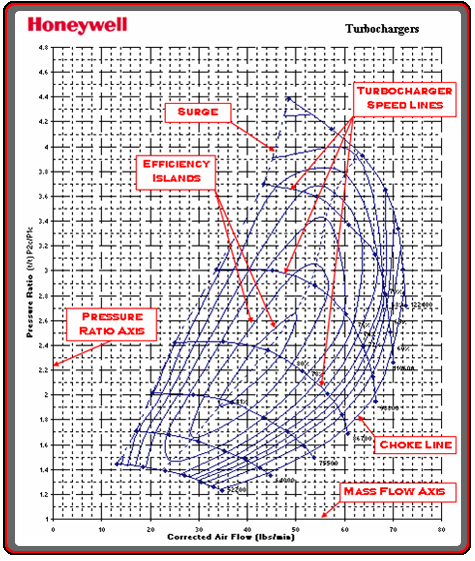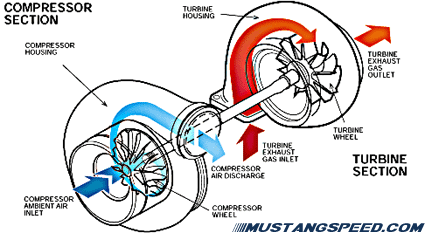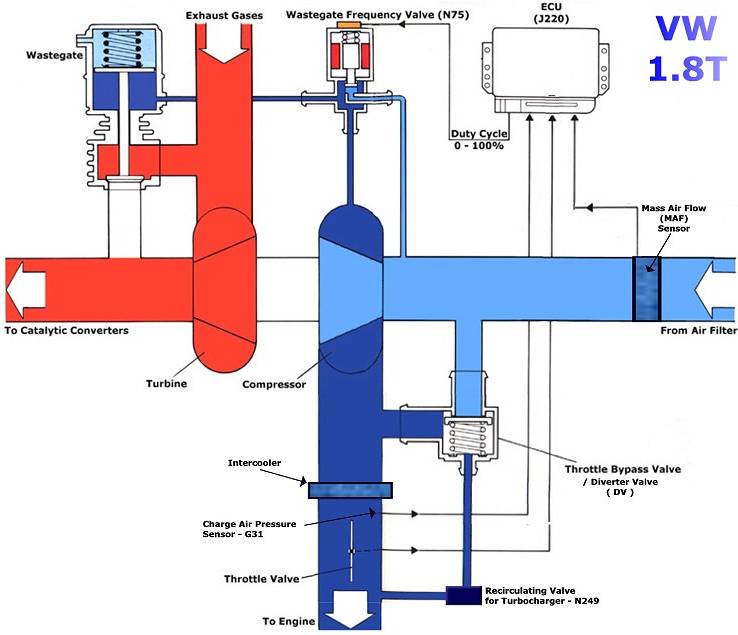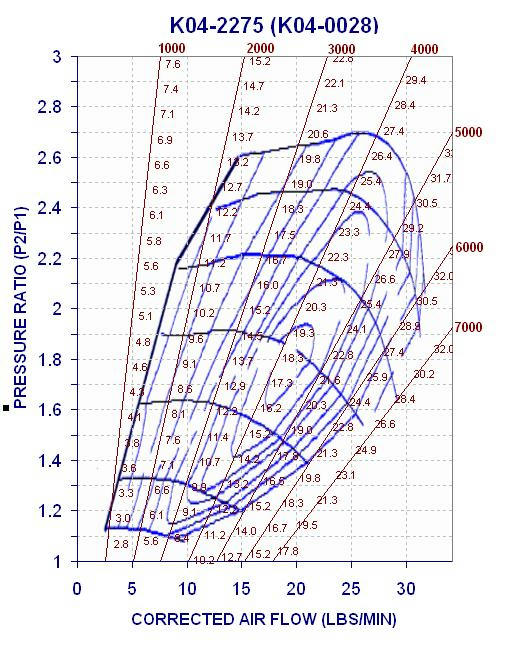For some it may seem common knowledge that a small turbo let's sat a KO3 at 20psi, will not produce the same power as a larger turbo (say a GT3071) @ the same 20psi.
This is because the larger turbo has a higher CFM at the same psi.
CFM= cubic/feet per minute and is a MEASURE OF VOLUMETRIC FLOW (sorry for the confusion)
PSI= pound/square inch and is a measurement of Pressure
Because the larger turbo has a larger turbine it
1.has a higher rotational mass, therefore takes longer to spool up.. Hence LAG
2.Has bigger "blades" on it's compressor wheel, therefore it does not need to spin as fast to produce the same CFM as the smaller turbo
Because smaller turbos spin faster they in turn heat up the air quite a bit more, thus the need for a more efficient I/C setup
Larger Turbos use larger wastegates with larger springs. The wastegate is essentially an alternative route that exhaust gasses can take to exit the manifold. turbo uses the spent exhaust gasses as the flow out of the engine to spin a compressor wheel (common knowledge correct?) but some do not know that the wastegate is there so that when the turbo is not needed to create boost, it can reroute or partially reroute the exhaust gas around the turbo in effect causing less/lower CFM.
Here is an excerpt from CHAD on starquestclub.com (regarding CFM vs.psi)
It's very dynamic, the whole thing is driven by exhaust volume and pressure on the turbine wheel, which is dictated by the CFM's the motor is drawing in, which is forced in by the comperssor wheel. You can't have one without the other, and they both effect each other.
It's nearly impossible to predict any specific scenerio of x + y / z * w = a where you have pressure, CFM, RPM's, effeiency, and resulting power.
It's more of a relationship thing than an exact science.
yes, a small motor with a lot of exhaust pressure will cause a turbo to build boost due to bottle necking, but then a small motor won't likely be able to make enough exhaust pressure to accomplish this task in the first place.
What you are describing there is a function ot turbine wheel to compressor wheel size ratios. If they are perfectly suited to the task they can do just about anything , but it's all tradeoffs.
If you take 2 turbos where one is exaclty twice the flow as the other, the smaller one will make boost sooner and easeir, and the larger will be later but improve topend power. If you compare HP at a the same pressure, the larger one will higher overal, but the smalelr one will accomplish it peak lower in the RPM band. The large one represents less resistance to exhasut flow, and is thus going to make more power for a given PSI. that is why bigger turbos spool later, but make more power. Because they make more power and flow more, they also have more exhaust pressure/volume, which adds even more to the equasion and shows up as increased power output for a given (equal) pressure.
It's like a 3 dimensional relationship.
It's nearly impossible to predict any specific scenerio of x + y / z * w = a where you have pressure, CFM, RPM's, effeiency, and resulting power.
It's more of a relationship thing than an exact science.
yes, a small motor with a lot of exhaust pressure will cause a turbo to build boost due to bottle necking, but then a small motor won't likely be able to make enough exhaust pressure to accomplish this task in the first place.
What you are describing there is a function ot turbine wheel to compressor wheel size ratios. If they are perfectly suited to the task they can do just about anything , but it's all tradeoffs.
If you take 2 turbos where one is exaclty twice the flow as the other, the smaller one will make boost sooner and easeir, and the larger will be later but improve topend power. If you compare HP at a the same pressure, the larger one will higher overal, but the smalelr one will accomplish it peak lower in the RPM band. The large one represents less resistance to exhasut flow, and is thus going to make more power for a given PSI. that is why bigger turbos spool later, but make more power. Because they make more power and flow more, they also have more exhaust pressure/volume, which adds even more to the equasion and shows up as increased power output for a given (equal) pressure.
It's like a 3 dimensional relationship.
Yah, I'd actually argue 5 dimensions since temperature is also a large factor. It's just hard to visualize 5 dimensions
The point is that it's not a linear relationship, and there are more than 2 variables in the origional question.
It could be argued there are dozens of varriables, such as A/R of of the housings and wheel trims, geometry of the manifold, speed and temperature of the exhaust, B.S.F.C. of the engine, elevation, etc.
Shaft speed is also important, air can only move so fast, a bigger turbo can move a given volume of air with a lower shaft speed, so they are far more efficent at high levels compared to a smaller turbo asked to do the same task. That is in part where a lot of the heat problems come from on small turbos turend all the way up, where a bigger turbo is probably a better choice.
The point is that it's not a linear relationship, and there are more than 2 variables in the origional question.
It could be argued there are dozens of varriables, such as A/R of of the housings and wheel trims, geometry of the manifold, speed and temperature of the exhaust, B.S.F.C. of the engine, elevation, etc.
Shaft speed is also important, air can only move so fast, a bigger turbo can move a given volume of air with a lower shaft speed, so they are far more efficent at high levels compared to a smaller turbo asked to do the same task. That is in part where a lot of the heat problems come from on small turbos turend all the way up, where a bigger turbo is probably a better choice.
Compressor maps are used to determine the CFM/PSI efficiency of turbos at given RPMS (of turbo)
And can be very useful when determining what turbo would be most effective for your project car.
Example:

WIKIPEDIA "compressor map"
Now I know this has been discussed in other sections and forums, but I thought I'd give the B7 crowd a taste and hopefully I can get Sprode to introduce himself then maybe we can get this thing stickied***
I will be editing this and adding so feel free to PM or post any misinformation or additional info you'd like to see.
SHANE













 Reply With Quote
Reply With Quote














Bookmarks